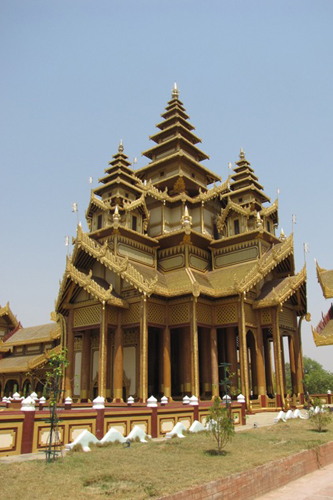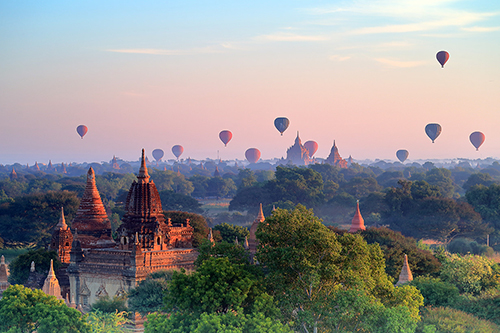Apart from the absence of kings and court, Bagan society has not changed radically; the people still harvest toddy juice for palm sugar, still plow their fields with bovine power, and retain the ancient traditions of hospitality, goodwill, and pride in their temples.
They continue with their ancestors' profession of making exquisite lacquerware and have revived some folk arts. The marionette stage, although not presented in the traditional form of all-nighters, return in shorter versions. Aspiring artists copy wall paintings on cloth covered with a layer of glued sand, giving it a texture similar to temple walls. A few painters have been commissioned to paint murals inside the smaller, renovated temples, and while their colorful drawings are now fresh, in time they too will show the patina of age. Many of the Bagan people value antiquity, but there are many more that, from deep religious beliefs, could not bear to see them in ruins.
Since Myanmar tourism has opened a way for them to show the world the nobility that was Bagan, and the glory that is retained in its temples, which have been living places of worship throughout the centuries.
The collection of the Bagan Archaeological Museum includes sandstone votive tablets, stone inscriptions such as the original Mya Zedi Stone of Prince Raja Kumar; free standing stone images; stone footprints and a rare cloth painting; Bagan era Buddhist iconography and rare images. The Lacquerware Museum has many ancient pieces on display.
All through history, religious buildings were constructed of brick but palaces were of wood and none survived today. West of Shwegu Gyi Temple, a replica of the palace of Kyansittha (1084-1112) has been built, according to the details left on four stone pillars.

For the annual pagoda festivals, families from villages in the vicinity arrive in caravans of bullock carts and stay the whole ten or fourteen days of the festival's duration. These country fairs attract the attention of travelers from all over the country and all over the world, There are stalls selling traditional goods like glazed pottery, the utensil of woven bamboo and cane, dried fish, homespun cotton, and farm utensils. Classical theatres of Zat Pwe or marionettes go on all night.
In the not-too-distant past, tourists taking Bagan tours were possible only on trucks or decrepit buses, which often broke down on the rough dirt roads. Then, the rest stops were small bamboo hut eateries, where truckers were served a set menu of a curry of choices such as beef, fish, chicken, mutton, river prawns or pork, and about a dozen free side dishes of local favorites: grilled, mashed and fried eggplant; peas cooked slow; lightly-fried greens or tender bamboo shoots; salads of pickled bean sprouts, tomatoes, string beans, or tamarind leaves; clear sweet soups or thick tart stews; a large tray of raw and blanched vegetables to dip with a hot and sour relish.
Now, upscale restaurants offer many varieties of cuisine from East and West but the best places are based on the menu setting of the old truck stops, only better. These 'Myanmar Buffets' serve for each customer, not one choice but all of the curry dishes and all of the dozen side dishes, at amazingly low prices. The vegetables, grown on the rich soil of the Ayeyarwady banks, are fresh and sweet.
In celebration or in the silence of the night, under the fierce tropical sun or wrapped in the hazy mauves of sunset, Bagan continues to calm the soul and, as warmly as ever, bring joy to the heart.

